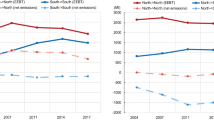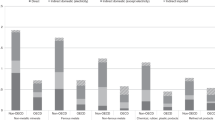Abstract
Carbon capture and storage is crucial to achieve net-zero targets and cross-border CO2 transport is essential for cost-efficiency of a carbon capture and storage strategy but how the public views this is unclear. Here, using multifactorial vignette experiments in four European countries and Canada, we show that cross-border transport hinders public acceptance of carbon capture and storage. Public concerns are unlikely to be offset by compensation, presenting a challenge for policy-makers.
This is a preview of subscription content, access via your institution
Access options
Access Nature and 54 other Nature Portfolio journals
Get Nature+, our best-value online-access subscription
$29.99 / 30 days
cancel any time
Subscribe to this journal
Receive 12 print issues and online access
$209.00 per year
only $17.42 per issue
Buy this article
- Purchase on Springer Link
- Instant access to full article PDF
Prices may be subject to local taxes which are calculated during checkout


Similar content being viewed by others
Data availability
The dataset analysed for this study is available through OSF.io28.
Code availability
The model codes constructed for the data analysis are available through OSF.io28.
References
IPCC: Summary for Policymakers. In Climate Change 2022: Mitigation of Climate Change (eds Shukla, P. R. et al.) (Cambridge Univ. Press, 2022).
Staff Working Document: Investment Needs Assessment and Funding Availabilities to Strengthen EU’s Net-Zero Technology Manufacturing Capacity SWD(2023) 68 (European Commission, 2023).
A Policy Framework for Carbon Capture and Storage in Europe (Clean Air Taskforce, 2022).
Fuss, S. et al. Moving toward net-zero emissions requires new alliances for carbon dioxide removal. One Earth 3, 145–149 (2020).
Business Models for Commercial CO2 Transport and Storage (Zero Emissions Platform, 2014); https://zeroemissionsplatform.eu/wp-content/uploads/ZEP-report-on-Business-Models-for-Commercial-CO2-Transport-and-Storage.pdf
Pianta, S., Rinscheid, A. & Weber, E. U. Carbon capture and storage in the United States: perceptions, preferences and lessons for policy. Energy Policy 151, 112149 (2021).
Arning, K. et al. Same or different? Insights on public perception and acceptance of carbon capture and storage or utilization in Germany. Energy Policy 125, 235e249 (2019).
Whitmarsh, L., Xenias, D. & Jones, C. R. Framing effects on public support for carbon capture and storage. Palgrave Commun. 5, 17 (2019).
Merk, C., Liebe, U., Meyerhoff, J. & Rehdanz, K. German citizens’ preference for domestic carbon dioxide removal by afforestation is incompatible with national removal potential. Nat. Commun. Earth Environ. 4, 100 (2023).
Merk, C., Andersen, G., Nordø, Å. D. & Helfrich, T. Carbon Capture and Storage—Publics in Five Countries Around the North Sea Prefer to Do It on Their Own Territory Kiel Working Paper 2252 (IFW, 2023); www.ifw-kiel.de/publications/carbon-capture-and-storage-publics-in-five-countries-around-the-north-sea-prefer-to-do-it-on-their-own-territory-31758
Merk, C., Dyrnes Nordø, Å., Andersen, G., Martin Lægreid, O. & Tvinnereim, E. Don’t send us your waste gases: public attitudes toward international carbon dioxide transportation and storage in Europe. Energy Res. Social Sci. 87, 102450 (2022).
Wuestenhagen, R., Wolsink, M. & Buerer, M. Social acceptance of renewable energy innovation: an introduction to the concept. Energy Policy 35, 2683–2691 (2007).
Bergquist, M., Nilsson, A., Harring, N. & Jagers, S. C. Meta-analyses of fifteen determinants of public opinion about climate change taxes and laws. Nat. Clim. Change 12, 235–240 (2022).
Coleman, E. A., Harring, N. & Jagers, S. Policy attributes shape climate policy support. Policy Stud. J. 51, 419–437 (2023).
Liebe, U., Bartczak, A. & Meyerhoff, J. A turbine is not only a turbine: the role of social context and fairness characteristics for the local acceptance of wind power. Energy Policy 107, 300–308 (2017).
Liebe, U. & Dobers, G. M. Measurement of fairness perceptions in energy transition research: a factorial survey approach. Sustainability 12, 8084 (2020).
Lokuge, N., Phillips, J. Anders, S. & van der Baan, M. Human-induced seismicity and the public acceptance of hydraulic fracturing: a vignette experiment. Extr. Ind. Soc. 15, 101335 (2023).
Buck, H. J. Social science for the next decade of carbon capture and storage. Electr. J. 34, 107003 (2021).
Cox, E., Spence, E. & Pidgeon, N. Public perceptions of carbon dioxide removal in the United States and the United Kingdom. Nat. Clim. Change 10, 744–749 (2020).
Consultation on the List of Candidate Projects of Common Interest in Cross-border Carbon Dioxide (CO2) Transport Networks (European Commission, 2021); https://energy.ec.europa.eu/consultations/consultation-list-candidate-projects-common-interest-cross-border-carbon-dioxide-co2-transport_en#reference-documents
Dunphy, N. P., Velasco-Herrejón, P., Lennon, B. & Smith, A. L. Engaging effectively with public(s) in the realization of CCS projects. In Proc. 16th Greenhouse Gas Control Technologies Conference (GHGT-16) 1–8 (SSRN, 2022).
Haemmerli, L. & Stauffacher, M. The neglected role of risk mitigation perception in the risk governance of underground technologies—the example of induced seismicity. Int. J. Disaster Risk Sci. 11, 630–639 (2020).
Braun, C. Not in my backyard: CCS sites and public perception of CCS. Risk Anal. 37, 2264–2275 (2017).
Boudet, H. Public perceptions of and responses to new energy technologies. Nat. Energy 4, 446–455 (2019).
Schlosberg, D. Defining Environmental Justice. Theories, Movements and Nature (Oxford Univ. Press, 2007).
Krevor, S. et al. Subsurface carbon dioxide and hydrogen storage for a sustainable energy future. Nat. Rev. Earth Environ. 4, 102–118 (2023).
Zuch, M. & Ladenburg, J. Navigating the information pathway to carbon capture and storage acceptance: patterns and insights from a literature review. Energy Res. Social Sci. 105, 103283 (2023).
Anders, S., Meyerhoff, J. & Liebe, U. Dataset for ‘Cross-border CO2 transport decreases public acceptance of carbon capture and storage. OSF.io https://doi.org/10.17605/OSF.IO/AQ8ND (2024).
Acknowledgements
This work is part of the ACT3 (Accelerating CCS Technology) initiative ENSURE project no. 327317. S.A. acknowledges funding for this study from ACT3 (grant agreement no. 327317; ‘ENSURE’ project). The project is a cooperation of NORSAR, the University of Alberta, Total Energies One Tech, Shell Global Solutions International, the Quest venture, operated by Shell Canada Ltd and owned by Canadian Natural Resources Limited, Chevron Canada Oil Sands Partnership and Shell Canada Ltd, Alcatel Submarine Networks, Midwest Regional Carbon Initiative (MRCI), INGV and BP. It is funded by Emissions Reduction Alberta (ERA), the French Environment and Energy Management Agency (ADEME) and the Research Council of Norway (RCN). We thank M. van der Baan for assistance in the attribute design of the vignette experiment.
Author information
Authors and Affiliations
Contributions
S.A., U.L. and J.M. have equally contributed to the work presented in this article.
Corresponding author
Ethics declarations
Competing interests
The authors declare no competing interests.
Peer review
Peer review information
Nature Climate Change thanks Katrin Arning, Sverker Jagers and Åsta Dyrnes Nordø for their contribution to the peer review of this work.
Additional information
Publisher’s note Springer Nature remains neutral with regard to jurisdictional claims in published maps and institutional affiliations.
Supplementary information
Supplementary Information
Supplementary Tables 1–3, acceptance ratings, descriptive and multivariate findings; Tables 4–6, fairness ratings, descriptive and multivariate findings; Table 7, experimental design; Table 8, vignette order effects; Table 9, tendency towards middle-point ratings; and Tables 10–15, the relevance of knowledge effects; Figs. 1–4, information provided to respondents, and references.
Rights and permissions
Springer Nature or its licensor (e.g. a society or other partner) holds exclusive rights to this article under a publishing agreement with the author(s) or other rightsholder(s); author self-archiving of the accepted manuscript version of this article is solely governed by the terms of such publishing agreement and applicable law.
About this article
Cite this article
Anders, S., Liebe, U. & Meyerhoff, J. Cross-border CO2 transport decreases public acceptance of carbon capture and storage. Nat. Clim. Chang. (2024). https://doi.org/10.1038/s41558-024-02023-0
Received:
Accepted:
Published:
DOI: https://doi.org/10.1038/s41558-024-02023-0



